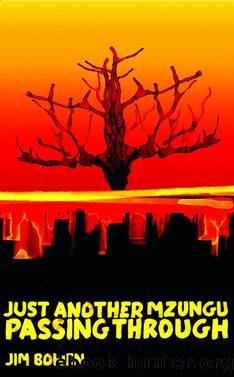Just Another Mzungu Passing Through by Jim Bowen

Author:Jim Bowen [Jim Bowen]
Language: eng
Format: epub
ISBN: 9781908069504
Publisher: Parthian Books
Published: 2011-10-15T00:00:00+00:00
20
I spent most of my holidays in Nairobi coaching and playing cricket, and while many of the Greenfields European staff flew home, and the Kenyans headed off to their home-places up country, I stayed in my little bedsit. Glen gave me a lift into the slums four days a week, so I was in Kawongware on Tuesdays and Wednesdays and in Mukuru to the south-east of the city on Mondays and Fridays. The rest of the time I walked around Nairobi and took trips out of the city to Karen Village, the giraffe farm and the animal sanctuary, or I borrowed one of Greenfieldsâ vehicles and crawled around Nairobi National Park. I sat on a bench on Hyrax Hill watching the small hairy rock hyraxes scuttling around near my feet. They looked like large guinea-pigs but, in some strange evolutionary twist, are more closely related to elephants. They made pleasant companions as I finally found the time to finish Tales from a Fragile Continent and histories of Nairobi.
Nairobi is a capital city that developed from a railway depot midway along the Mombasa-Entebbe Railway, paid for by British money and built by the sweat and lives of labouring Indian âcooliesâ. It is high enough to be malaria-free and cooler than the Great Rift Valley to the west or the Athi Plains which swept out eastwards. The Masai called it Ewasso Nairobi â Place of Cool Water â and the British named it the âCity in the Sunâ. The soil suited their gardens, and the seasons reminded them of home, so the British settlers thought they had landed in heaven.
From the smart hills of Muthaiga, to Happy Valley in the Central Highlands, the European settlers led privileged lives and had wild times. With the sweep of a generalâs pen across a map of East Africa, Uganda, Tanzania, Somalia and Kenya were created, and the different tribes in each of these âcountriesâ became one nation. The Luo, Kikuyu, Masai, the gentle Giriama people on the coast, and around forty other tribes who had little in common, became Kenyans.
Eventually Kenya developed into what it is today â the flawed but magnificent jewel of East Africa, with enough good agricultural land to be self-sufficient in food, and a tourism industry to compete with any in the world.
Kenyaâs potential is limitless, but with no word in Kiswahili for âmaintenanceâ and the tradition of overseas aid handouts and officials creaming off chai at every level, Kenya is full of half-finished, externally-funded projects. They are abandoned, as international agencies and charities invest and then pull out regretfully when they see their money being frittered away. When Clare Short, the then Secretary of State for International Development, visited Kenya in 1997, President Moi told her it was Britainâs duty to always support Kenya as a parent has a duty to support a child. Self-sufficiency and true freedom for the nation were never Moiâs top priority.
Day-to-day living is the same in Kenya as everywhere else. It is filled with the struggle to find shelter, feed the family and make it through until morning.
Download
This site does not store any files on its server. We only index and link to content provided by other sites. Please contact the content providers to delete copyright contents if any and email us, we'll remove relevant links or contents immediately.
The Fine Print (Dreamland Billionaires Book 1) by Lauren Asher(2493)
Fury of Magnus by Graham McNeill(2397)
The Last House on Needless Street by Catriona Ward(2296)
The Rose Code by Kate Quinn(2145)
A Little Life: A Novel by Hanya Yanagihara(1922)
Malibu Rising by Taylor Jenkins Reid(1854)
Luster by Raven Leilani(1845)
Transcendent Kingdom by Yaa Gyasi(1808)
Moonflower Murders by Anthony Horowitz(1794)
The God of the Woods by Liz Moore(1706)
The Lost Book of the White (The Eldest Curses) by Cassandra Clare & Wesley Chu(1613)
This Changes Everything by Unknown(1467)
The Midwife Murders by James Patterson & Richard Dilallo(1435)
The Lying Life of Adults by Elena Ferrante(1393)
The New Wilderness by Diane Cook(1392)
Wandering in Strange Lands by Morgan Jerkins(1371)
Written in the Stars by Alexandria Bellefleur(1356)
Ambition and Desire: The Dangerous Life of Josephine Bonaparte by Kate Williams(1342)
The Lying Life of Adults by Elena Ferrante;(1272)
